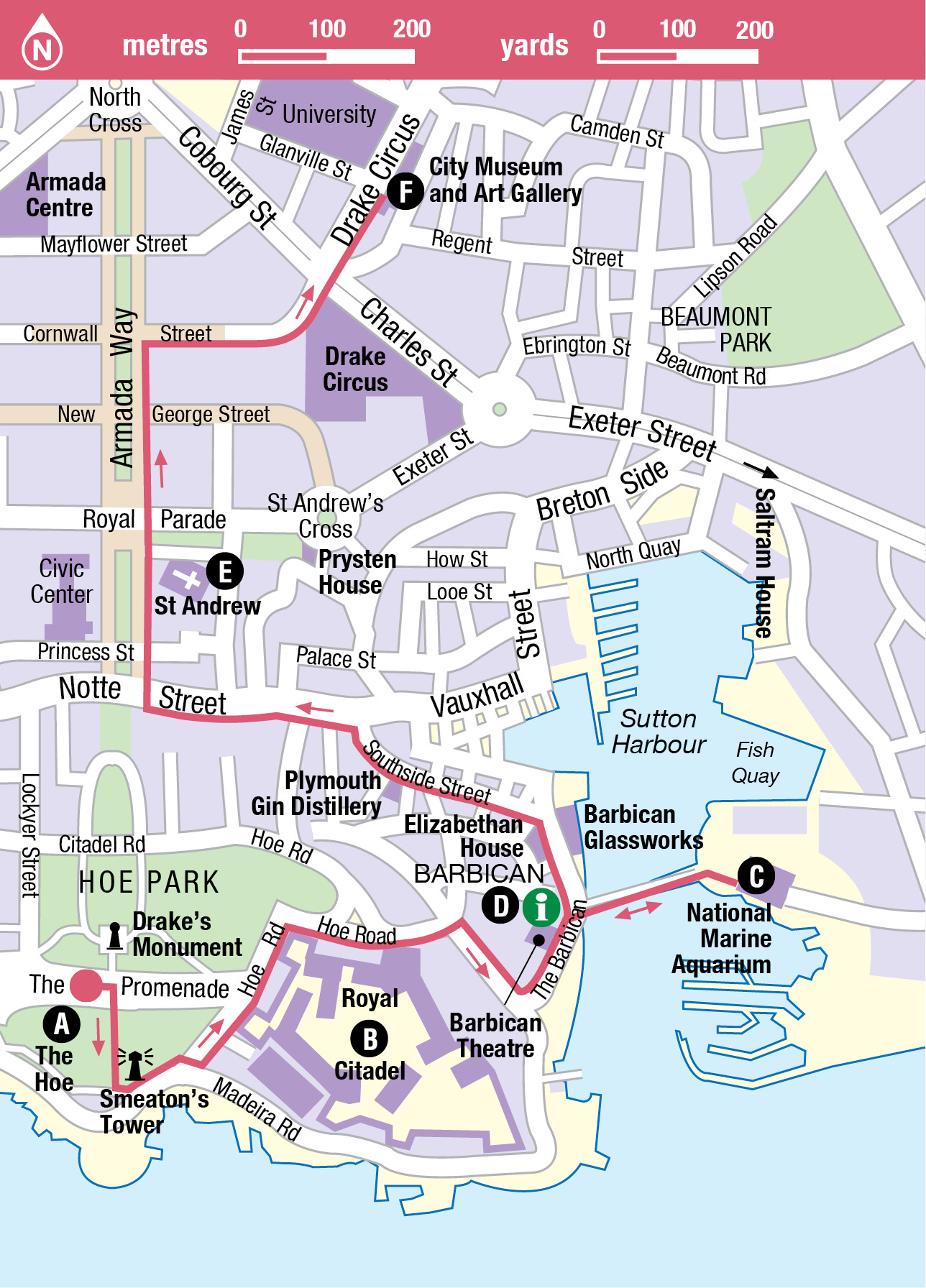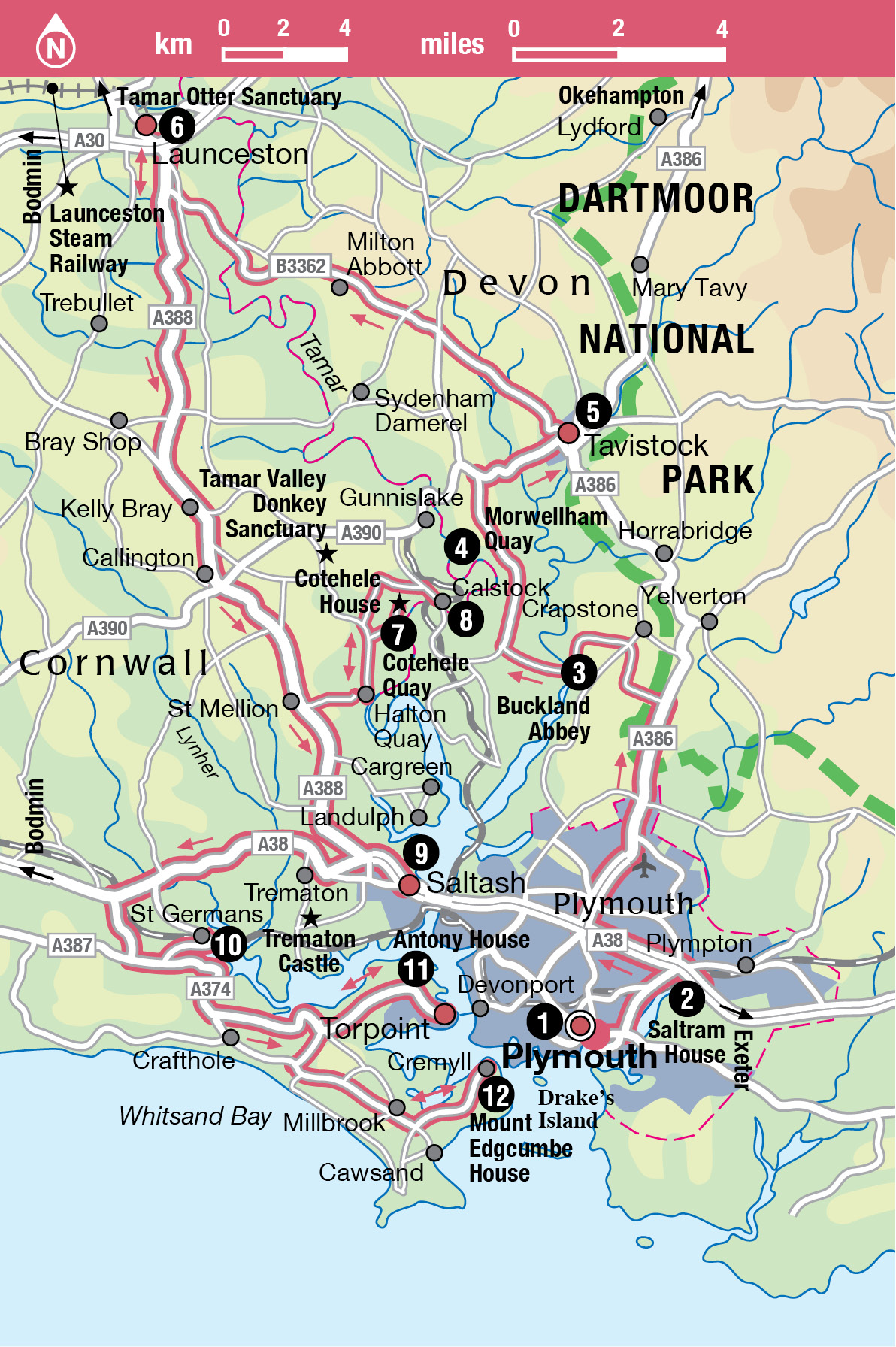The largest city in Devon, and a major naval base, Plymouth 1 [map] (pop. 256,400) was so damaged in the last war it is mostly a new town. It was once three townships: Dock (now Devonport), Sutton and Stonehouse. The natural harbour, formed where the Tamar and Plym rivers debouch into the Sound, was already a significant port in the 14th century, controlling the English Channel. Numerous discoverers and pioneers set off on their epic voyages from here: Drake, Hawkins, Raleigh, Cook, the Pilgrim Fathers and half a million emigrants.
One night in 1941, 1,000 people were killed and 20,000 homes destroyed by German bombs. After the war, town planners scrapped what remained and started again. The result is a pedestrian shopping centre surrounded by traffic.
Although it is only a few miles from the downtown stores to the bleak uplands of Dartmoor, the contrast couldn’t be greater.
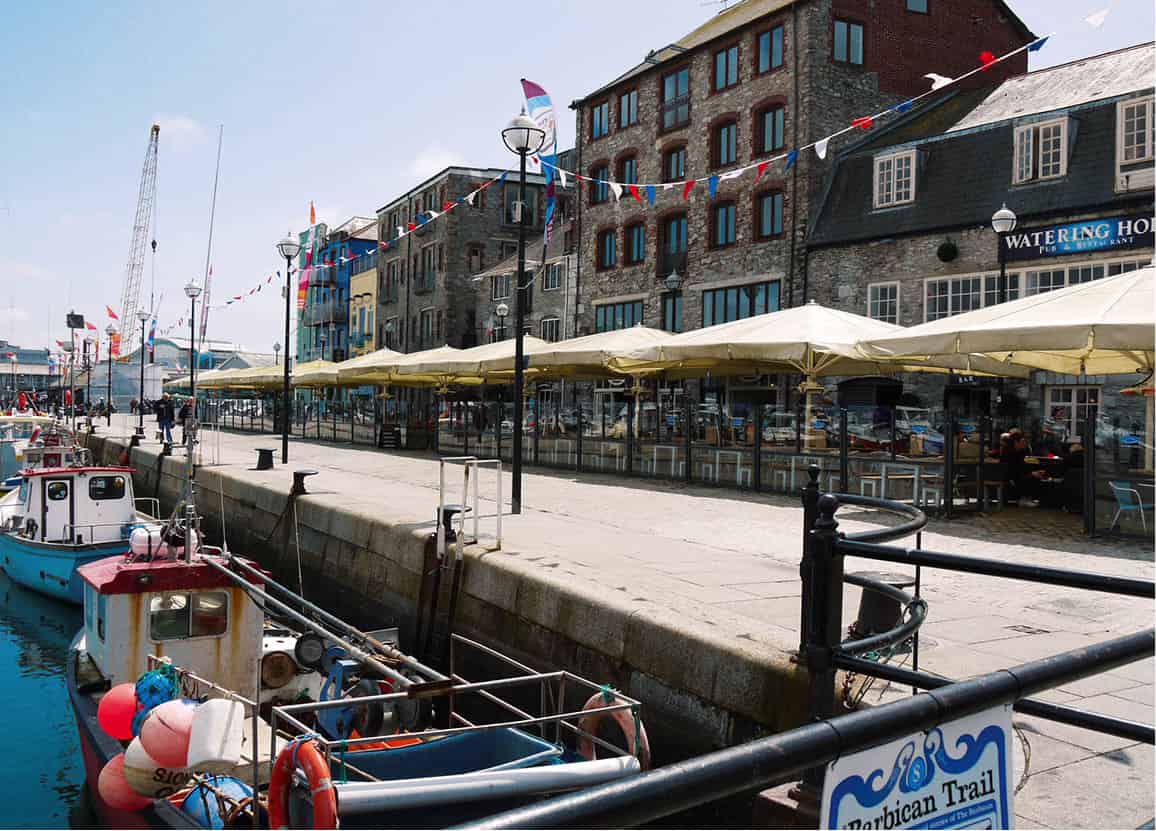
The Barbican.
Tom Smyth
The Hoe
The setting for many of Plymouth’s best dramas is the Hoe A [map] (old English for ‘high place’), a broad, breezy, grassy shoulder between town and sea. It commands an extraordinary view of the Sound, laid out below like an amphitheatre. This is where Sir Francis Drake was alleged to have been playing bowls when the Spanish Armada arrived in 1588.
In the far distance (14 miles/23km), the Eddystone lighthouse can be seen on a clear day. The current lighthouse is the fourth; the third, Smeaton’s Tower, now stands on the Hoe, and is open to the public.
Several memorials line the Hoe leading to the formidable walls of the Royal Citadel B [map]. The fort was completed in 1671 by Charles II, shortly after Plymouth had taken the anti-royalist side in the Civil War, and its guns face both ways – over the city and the sea – although they have never been fired in anger. The Citadel is garrisoned by the Royal Artillery.
Well landscaped into the front brow of the Hoe is the Dome, a former innovative multi-media presentation of Plymouth’s past and present, which is now a restaurant.
Plymouth’s old Aquarium used to be here, but has since been reborn as the grand National Marine Aquarium C [map] (tel: 0844-893 7938; www.national-aquarium.co.uk; daily, daily 10am–5pm) on the east side of Sutton Harbour. It’s the largest aquarium in the UK.

Smeaton’s Tower, now high and dry on the Hoe, once stood on a rock far out to sea.
Tom Smyth
Sutton Harbour is the watery part of the Barbican D [map], a preserved corner of Plymouth as it used to be, from where many of Plymouth’s historic voyages started out. The Barbican’s shops, restaurants and galleries are attractively located in converted warehouses and merchants’ houses, particularly along Southside Street. Towards the end of the street you’ll find the Plymouth gin distillery, which welcomes visitors.
Plymouth is a city without a cathedral. St Andrew’s E [map], its principal church, was largely rebuilt following the war, and is notable for striking glass windows by artist John Piper, as well as graffiti scratched into the masonry which is thought to celebrate Drake’s voyage round the world.
The City Museum and Art Gallery F [map] (Drake Circus; tel: 01752-304 774; Tue–Fri 10am–5.30pm, Sat 10am–5pm), behind the main shopping area, reflects local interests in a generalised collection, but also has some fine paintings by artists including Sir Joshua Reynolds and the Newlyn School’s Stanhope Forbes.
The River Tamar
Nothing has done more to keep Cornwall Cornish than the River Tamar. From its springs at Woolley Barrows, just a few miles from the north Cornish coast, down to Plymouth Sound, it proved an effective barrier against the Romans and the Anglo Saxons, and provided broad waters and landing places for the ships that took away the produce of Cornish mines (copper and tin) and its quarries (granite and slate).
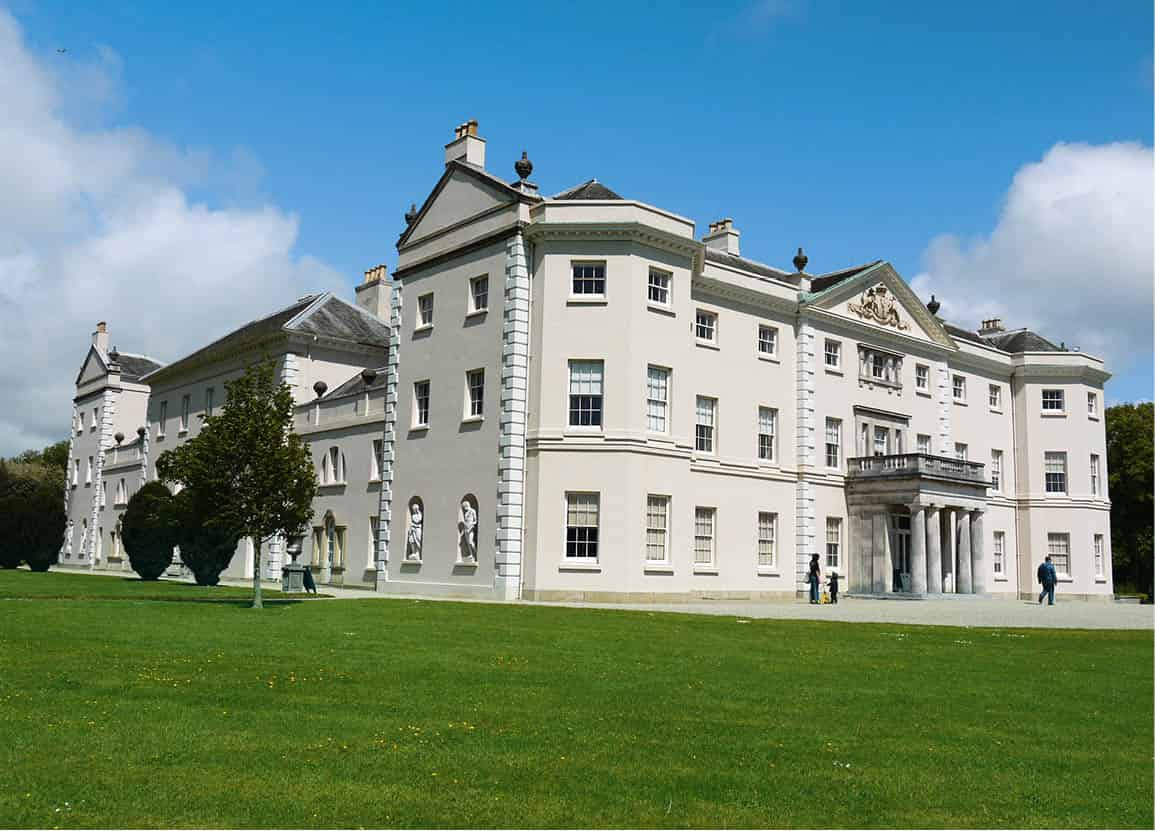
Saltram House has year-round events including jazz picnics and theatre.
Tom Smyth
Devon Wonders
Just off the A38 3 miles (5km) east of Plymouth stands the grand Saltram House 2 [map] (NT; tel: 01752-333 500; Mar–Oct daily 11am–4.30pm, Nov–Dec 11am–3.30pm, mid-Feb–end Feb weekends only), Devon’s largest country house, in 470 acres (190 hectares) of grounds and 13 acres (5.3 hectares) of gardens. It has a fine Robert Adam interior and most of its furnishings are original. The house served as the Dashwood family home in the film of Sense and Sensibility.
Some 8 miles (13km) north of Plymouth, just off the A386 en route to Tavistock, are two West Devon highlights. Buckland Abbey 3 [map] (NT; tel: 01822-853 607; Mar–Oct daily 10.30am–5.30pm, winter check for times) belonged to the Cistercian order and dates from 1278. Dissolved under Henry VIII, it became a wonderful Elizabethan mansion, and home of Drake, who was born in nearby Tavistock. He bought the house in 1580 from his rival Sir Richard Grenville for £3,400.

Beautifully preserved Morwellham Quay shows how the copper was transported on the Tamar.
Tom Smyth
Four miles (6km) north is Morwellham Quay 4 [map] (tel: 01822-832 766; www.morwellham-quay.co.uk; daily 10am–5pm, closes 6pm Jun–Aug, winter 4pm), the highest navigable point on the Tamar. Morwellham is a superbly preserved and presented snapshot of how industry and thus transport ebbed and flowed in the region in Victorian times. It is set in a lovely valley, and animated by staff in period costume.
Morwellham existed as a port for a thousand years before the discovery of huge copper deposits in the region demanded the provision of heavy transport – so much so that a canal was cut from Tavistock to the hills above Morwellham, from where an inclined railway ran down to the quay. Eventually the mines were exhausted and the railway arrived, killing off water transport. Morwellham disappeared under weeds until 1970, when it became a project of the Dartington Trust which lovingly restored and created its museums and trails.
Tavistock
The pleasant old market town of Tavistock 5 [map] benefited enormously from the prosperity of local copper and tin mining. The landowning Russell family (dukes of Bedford) created the town as it looks today, particularly the main Bedford Square. Plunge through the arch near the tourist office and you will reach the town’s active and characterful pannier market. Tavistock is only 10 miles (16km) from Plymouth, but with its weathered stone buildings it belongs to another world.
Launceston
Take the B3362 about 12 miles (19km) northwest to Launceston 6 [map]. Just 1 mile (1.6km) before the walled city you will cross the River Tamar into the county of Cornwall.
Launceston was Cornwall’s principal town until civic power was transferred to Bodmin in 1835. A Victorian revival gave it a town hall and a guildhall, but its most interesting building is St Mary Magdalene, once the castle chapel and now the parish church. Go out via the North Gate into elegant 18th-century Castle Street. Lawrence House Museum (www.lawrencehousemuseum.org.uk; Apr–Oct Mon–Fri 10.30am–4.30pm; free) was originally built in 1753 for a lawyer.

Launceston Steam Railway runs along the lovely Kensey Valley.
Lydia Evans/Apa Publications
Launceston Castle
Launceston Castle (Apr–Oct daily 10am–5pm) sits in grounds immaculately maintained by English Heritage. The steep ascent to the keep is worthwhile for the astounding views from the top – not only of the town but also over Bodmin Moor and Dartmoor. William the Conqueror gave his half-brother, the Earl of Mortain, the land surrounding a hill site already fortified by Edward the Confessor and commanding the approaches to the west. Within a year the hill was crowned with the castle of Dunheved, a keep on an artificial motte, with bailey, walls and gates enclosing the settlement. Launceston was born, secure from English resistance. A small display traces the castle’s 1,000 years of history.
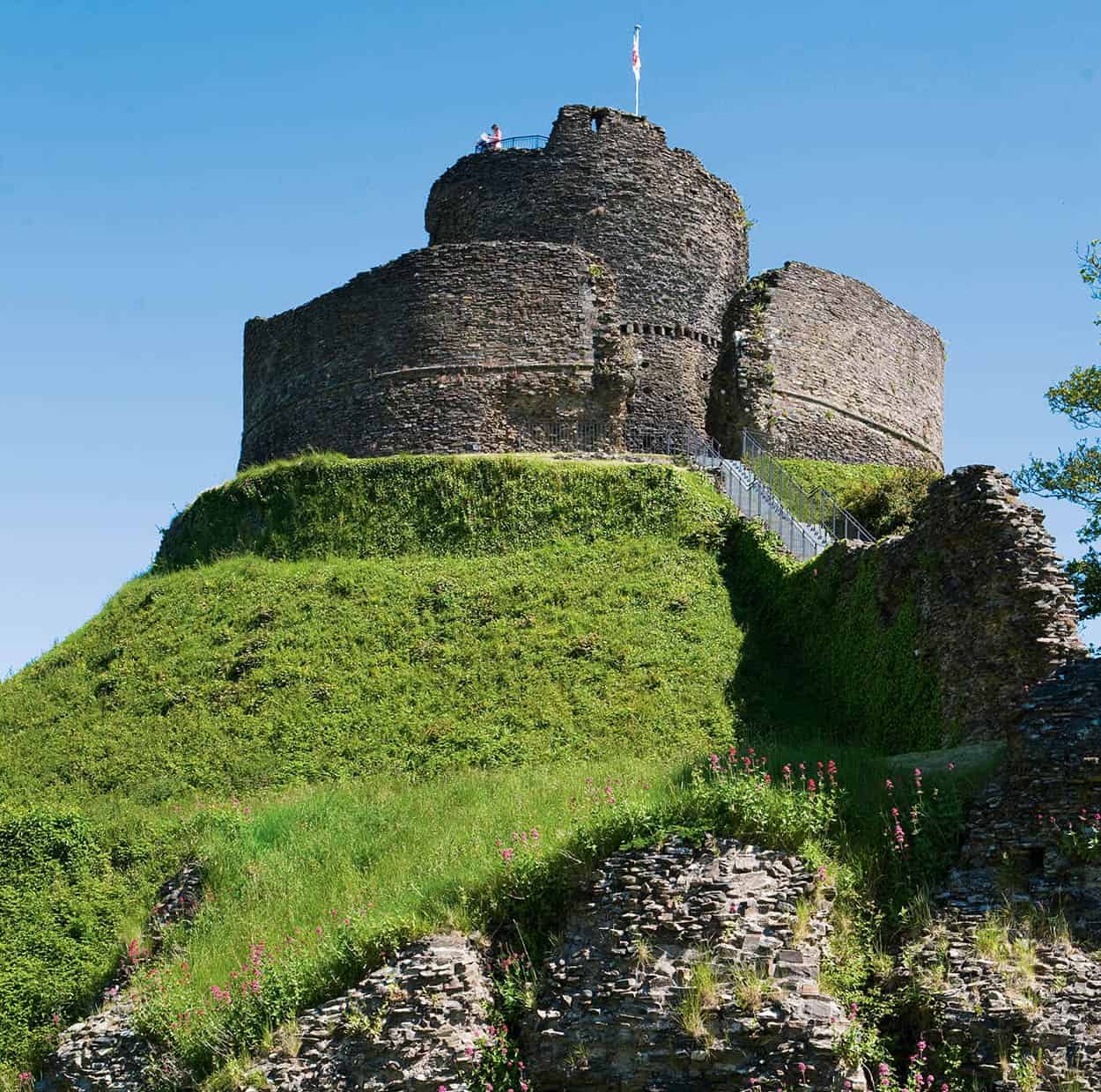
The lofty castle keep.
Lydia Evans/Apa Publications
North of the centre is the Launceston Steam Railway (tel: 01566-775 665; www.launcestonsr.co.uk for hours and timetable; not Sat or winter). There is a museum, workshops and buffet and the old locomotives run 2.5 miles (4km) to Newmills.
The Tamar Valley
From Launceston, the A388, the major road south, deserts the Tamar, but our tour turns left at St Mellion and winds its way through pretty lanes to Cotehele Quay 7 [map]. Evidence of a once-busy trading place is captured in a museum, wharf buildings and the Shamrock, the last Tamar sailing barge. There’s a National Trust tearoom, a watermill and recreated workshops just a short walk through the woods, or you can take the shuttle bus.

Set in vast grounds, Cotehele House has a wonderful textile collection.
Lydia Evans/Apa Publications
Animal Rescue
Two children’s animal favourites are accessible from Launceston. About 14 miles (22km) southeast is Tamar Valley Donkey Park and Sanctuary (tel: 01822-834 072; www.donkeypark.com; Apr–Sept daily 10.30am–5pm, Oct Thu–Sun 10.30am–4.30pm, Nov–Mar Sat–Sun and school holidays). While north, off the A390 near Callington, you’ll find the Tamar Otter Sanctuary (tel: 01566-785 646; www.tamarotters.co.uk; Apr–Oct daily 10.30am–6pm), plus meerkats, wallabies, wildcats and birds of prey.

Otters awaiting rehabilitation.
Lydia Evans/Apa Publications
The complex relates to Cotehele House (NT; tel: 01579-351 346; daily mid-Mar–Oct 11am–4pm; garden all year dawn–dusk), a strong contender for the title of most beautiful stately home in the county. Built between 1485 and 1627, this great medieval building, hung with Flemish and English tapestries, is remarkably unchanged. In the chapel, a 15th-century clock, the earliest in England, still ticks, though it has no hands or pendulum.
A short riverside walk brings you to Calstock 8 [map]. River trade was ruined when the Tamar Valley railway line between Plymouth and Gunnislake was laid, but it gave the town one of the county’s most attractive branch lines. The views of the river from the viaduct are breathtaking.
Until Victorian times Gunnislake, several miles upriver from Calstock, was the lowest bridging point on the Tamar. New Bridge, dating from 1520, was the scene of bitter fighting during the Civil War (1642–6).
Saltash
Return to the A388 and drive south to Saltash 9 [map]. Isambard Kingdom Brunel’s magnificent Royal Albert Bridge straddled the Tamar in 1859 here, to bring broad-gauge railways into Cornwall, 9 miles (15km) south of Gunnislake. Not until 1961 did a new road bridge join Brunel’s, forcing the closure of a ferry that had operated for 700 years. The new A38 took traffic around Saltash, leaving it to rest on its memories, the oldest ones embedded in the tiny Tudor cottage in Culver Road, where Sir Francis Drake’s wife, Mary, was born. Mary Newman’s Cottage can be visited as part of the Heritage Trail (Easter–Oct Wed–Thu, Sat–Sun, noon–4pm; free), as can Elliott’s Grocery Store, a classic Saltash shop.

Brunel bridged the Tamar for the railways; the road bridge came later.
Lydia Evans/Apa Publications
Stunning views can be had from below the bridge, where 18th-century houses cluster side by side with modern housing in the steep streets and on the quayside.
St Germans
From Saltash, take the A38 westwards. High above a tidal creek of the Lynher River is Trematon Castle, an important Norman stronghold overlooking Plymouth Sound.
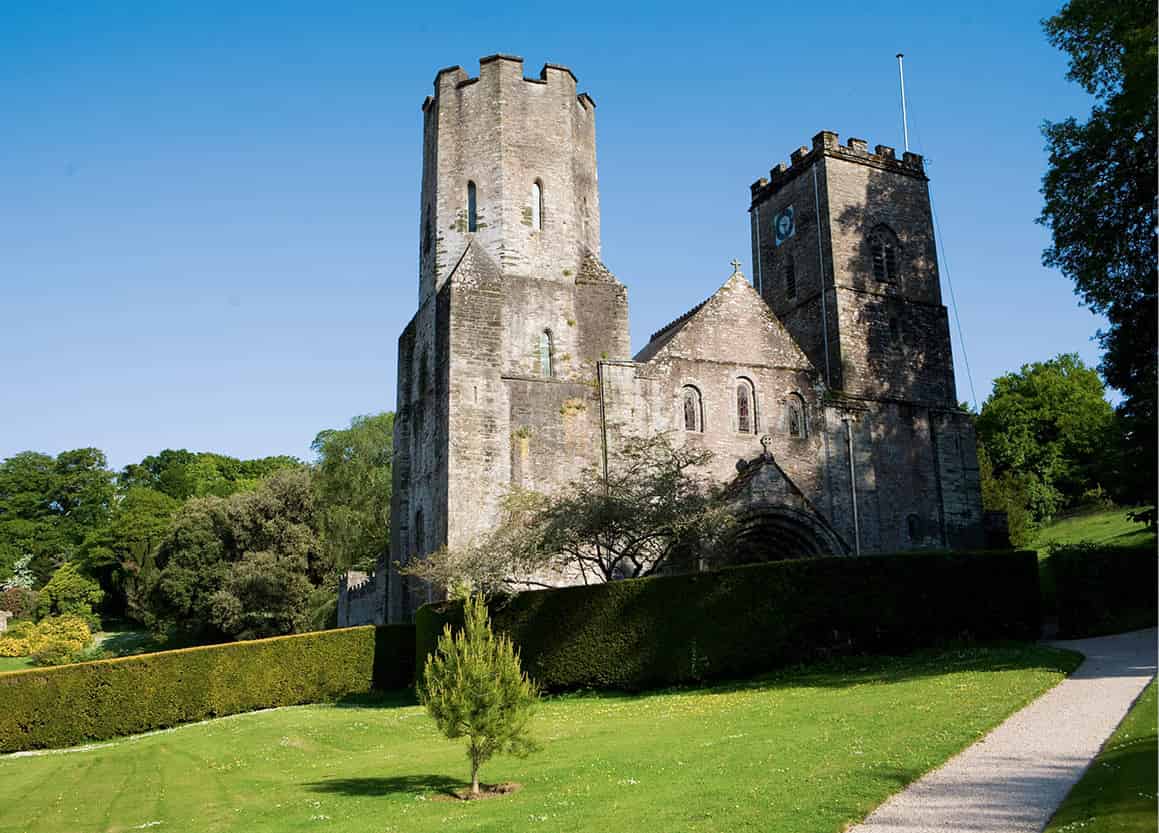
The church of St Germans, a former priory and once Cornwall’s cathedral.
Lydia Evans/Apa Publications
In Saxon times, the church at St Germans ) [map], reached via a narrow left turn off the A38, was Cornwall’s cathedral. After the bishops moved to Crediton, and later Exeter, it became an Augustinian priory, and the substantial remains of the Norman building are now the parish church.
Two Great Houses
The A38 joins the A374 to Torpoint and the Devonport ferry, passing Antony House ! [map] (NT; tel: 01752-812 191; Apr–Oct Tue–Thu 1–5pm, also Sun June–Aug; woodland garden Mar–Oct Tue–Thu, Sat–Sun 11am–5.30pm), by the River Lynher. Wings of red brick contrast with Pentewan stone and, although a little austere, it is one of the finest early 18th-century houses in Cornwall. Views of the river have been opened up in the 100-acre (40-hectare) park and woodland garden, landscaped by Humphry Repton.
From Antony House, head back to the main road junction and follow signs south for Millbrook. From the village, at the head of a tidal creek, a delightful lane follows the waterside to Mount Edgcumbe House @ [map] (tel: 01752-822 236; www.mountedgcumbe.gov.uk; Apr–Sept Sun–Thu 11am–4.30pm) and the entrance to the Country Park at Cremyll Ferry. The Edgcumbe family virtually abandoned their original home at Cotehele in favour of this new site overlooking Plymouth Sound.
Entrance to the 800-acre (320-hectare) park (all year daily) is free; it includes Cornwall’s only Grade I listed historic garden, the National Camellia Collection, follies, grottoes, an orangery, a conservatory and a holy well.
There are dramatic coastal views from walks that lead to Maker Church, the tower of which served as a semaphore station in the 18th century. The coastal path soon descends to Kingsand and Cawsand, separated by a stream. In the early 19th century both subsisted on smuggling, for which their twisting, turning lanes seem to have been specially designed. From here it is just a short hop over the Tamar Bridge to Plymouth.
Eating Out
Plymouth
River Cottage Canteen and Deli
Royal William Yard; tel: 01752-252 702; www.rivercottage.net; daily breakfast (from 11am), lunch and dinner.
Part of Hugh Fearnley-Whittingstall’s River Cottage empire. Great local food, served canteen-style in a stunning waterfront building – carefully sourced produce is the key. ££
The Waterfront
9 Grand Parade; tel: 01752-226 961; www.waterfront-plymouth.co.uk; daily 10am–11pm, closes 10.30pm Sun.
Sit on the nautical deck on the Hoe and order local crab linguine with garlic, chilli and lime or pan-fried sea bass. ££
Tavistock
The Cornish Arms
15 West Street; tel: 01822-612 145; www.thecornisharmstavistock.co.uk; daily lunch, dinner.
Exceptional food and beer can be found in this stylish, yet traditional pub. Chef John Hooker produces top-notch dishes using great local produce, such as Sladesdown duck from Ashburton. ££
Launceston
No. 8 Café & Deli
8 Westgate Street; tel: 01566-777 369; www.no8launceston.co.uk; Mon–Sat 8.30am–5pm.
Come here for a taste of Cornwall, in particular the great cream teas and the very popular breakfasts. Good coffee, sandwiches and salads, too. £
Saltash
Heskyn Mill
Tideford (just off A38 west of Saltash); tel: 01752-852 127; daily lunch and dinner.
In a delightful setting within an 18th-century corn mill, the food here is lovingly prepared and the service is attentive. Leave room for the luscious desserts. £
